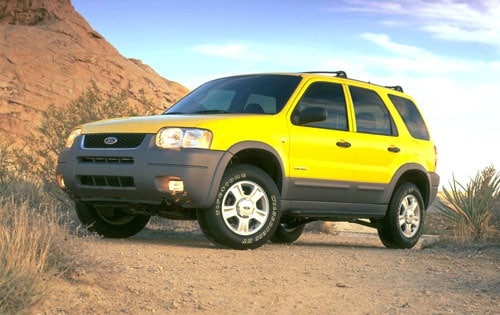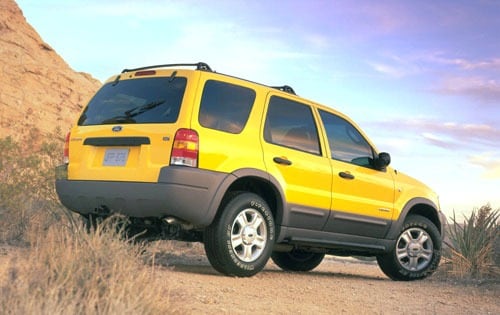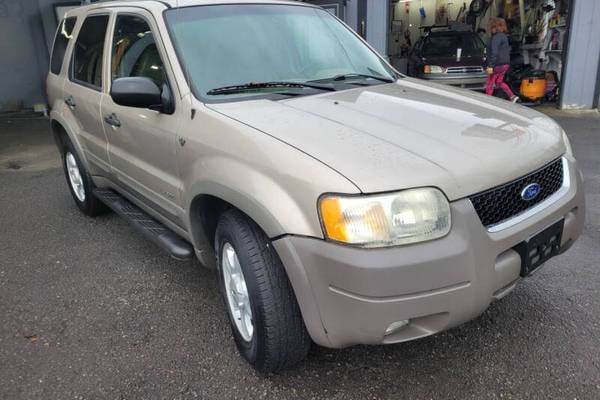2001 Ford Escape Review
Price Estimate: $771 - $1,296
 View 19 more photos
View 19 more photos View 19 more photos
View 19 more photos View 19 more photos
View 19 more photos View 19 more photos
View 19 more photos View 19 more photos
View 19 more photos+15
Edmunds' Expert Review
by the Edmunds Experts
Pros
- Strong V6 engine, plenty of interior space, car-like road manners.
Cons
- Lacks the off-road capability of a truck-based SUV, barely adequate base engine, unknown reliability.
What’s new
The Escape is Ford's new SUV. Smaller in size than the Explorer (and dwarfed by an Excursion), the 2001 Ford Escape competes in the same class as the Honda CR-V and Toyota RAV4. Its main calling cards are an optional V6 engine and a large interior.
For sale near Turlock, CA
15 listings
- 198,115 miles
- No accidents, 2 owners, personal use only
- 5 Seats, 20 City / 24 Hwy MPG
- American Dream Motors (726 mi away)
- AWD/4WD
- Alarm
- Rear Bench Seats
- Fold Flat Rear Seats
- 3500lb Towing Capaci...
Close
Located in Everett, WA
CASH special!! Price is FIRM!!
AutoCheck Vehicle History Summary
Accident Free Vehicle: Yes
Personal Use Only: Yes
History Provider: AutoCheck
Title Details: Clean Title
Salvage Vehicle: No
Frame Damage: No
Theft History: No
Lemon Status: No
Free History Report: No
Features and Specs:
21 Combined MPG (20 City/24 Highway)
Listing Information:
VIN: 1FMCU04171KB03230
Stock: B03230
Certified Pre-Owned: No
Listed since: 03-28-2025- 145,170 miles
- Insurance loss reported, 2 owners, personal use only
- 5 Seats, 21 City / 26 Hwy MPG
- Cransh Auto Sales (1,375 mi away)
- Alarm
- Rear Bench Seats
- Fold Flat Rear Seats
- 3500lb Towing Capaci...
- Audio and cruise con...
Close
Located in Arlington, TX
TRADE IN SPECIAL! **PREVENTATIVE MAINTENANCE JUST COMPLETED WITH NEW TIRES** ONE OWNER **CARFAX CERTIFIED** WITH 20 HISTORY RECORDS AND HAS ALWAYS BEE...
AutoCheck Vehicle History Summary
Accident Free Vehicle: No
Personal Use Only: Yes
History Provider: AutoCheck
Title Details: Issue reported
Salvage Vehicle: No
Frame Damage: No
Theft History: No
Lemon Status: No
Free History Report: No
Features and Specs:
23 Combined MPG (21 City/26 Highway)
Listing Information:
VIN: 1FMYU03111KA88764
Stock: A88764
Certified Pre-Owned: No
Listed since: 06-29-2025
Vehicle overview
One of the benefits of coming late to the party is that when you do arrive, you can make a big splash. That's what Ford is doing with the 2001 Escape.
Designed to battle the Honda CR-V, Nissan Xterra, Toyota RAV4 and others of the small-SUV ilk, the five-passenger Escape is marked by a larger interior and a more powerful optional engine. As an added bonus, it's also priced very competitively.
These factors position the Escape for tremendous success in a growing market. Developed in partnership with Mazda, Escape comes in XLS or XLT flavors. Base models have two-wheel drive and a 2.0-liter Zetec four-cylinder engine making 130 horsepower and 135 foot-pounds of torque.
Burdened with people and gear, a Zetec Escape is bound to be rather weedy. Fortunately, there is an optional Duratec 3.0-liter V6. With 200 horsepower and 200 foot-pounds of torque, it is the most powerful engine in its class. Equipped with the V6 and the standard four-speed automatic transmission, the Escape can tow up to 3,500 pounds. Both the four-cylinder and V6 engines are LEV compliant.
The Escape also comes in either two-wheel or four-wheel drive. As opposed to Ford's larger SUVs, the 2WD Escape is front-wheel drive. The 4WD system can be set to either "4x4 automatic" or "4x4 lock" mode. In automatic mode, power is applied to the rear wheels only when a loss of traction occurs. In the locked mode, the Escape applies power to all four wheels at all times. The Escape does not have a low-range transfer case, however.
Sporting rugged good looks, Ford hopes the Escape will appeal to young families and people with active lifestyles. Don't let the outside fool you, though. Underneath, the Escape is more car than truck. The unibody chassis is equipped with rack-and-pinion steering, a four-wheel independent suspension and four-wheel ABS through a front disc/rear drum arrangement. One particularly cool feature is the sturdy roof rack that slides rearward and hinges down to make loading and unloading up to 100 pounds of cargo easy. Attachments for skis and bikes will be available from Ford dealers.
Inside, the Escape offers a big allotment of space for passengers and cargo. Rear passengers get 36.9 inches of legroom. With the rear seats removed, The Escape offers 68.5 cubic feet of cargo. Cabin highlights include an optional six-disc in-dash CD changer and a 300-watt sound system, standard air conditioning and optional side airbags.
Ford claims affordability and durability were top priorities. Mazda's input should be of help here, but it is always difficult to determine reliability on a totally new platform such as the Escape. Regardless, Ford's Escape should be on your short list of mini-SUVs to look at.
Cost to Drive
Monthly estimates based on costs in California
$247/mo for Escape XLS
Escape XLS
vs
$224/mo
Avg. Compact SUV
See Edmunds pricing data
Has Your Car's Value Changed?
Used car values are constantly changing. Edmunds lets you track your vehicle's value over time so you can decide when to sell or trade in.

Ford Escape Owner Reviews
Most Helpful Owner Reviews
Trending topics
Awesome
4.63 out of 5 starsBC Prosser, 10/24/2010
2001 Ford Escape XLS 4WD 4dr SUV (2.0L 4cyl 5M)
Owned this escape since 2001 when it had 0 miles. It now has 235,000 and is still going. Never had any problems, original engine, transmission, clutch, and everything. New front struts/tie rods and brakes at 190k. Replaced the in-dash stereo, but left the speakers, they sound as good as the Bose speakers in our 2007 yukon denali. Vehicle drives great in all conditions, and still looks … like new when it's clean. The Escape has never let me down, and i hope to rely on it for years to come.
A great vehicle for the value
4 out of 5 starsMark, 02/26/2016
2001 Ford Escape XLS 4WD 4dr SUV (2.0L 4cyl 5M)
I was handed down this car from my cousin who wasn't big on maintenance such as oil changes that went unperformed to the point of dipstick scorching and driving on dry rotted tires, the original clutch still grabs great, cold starts are a snap and idle speed is nice and low at 500rpm. No major repairs needed after 180k miles just tires and minor rust repair. The thing handles great and … shifts while not as precise as a sports car can still be executed swiftly. If noise isn't your thing the 4 cylinder is much more pronounced than the more loaded v6 XLT. For great performance and dependability you can't beat these first gen Escapes.
Tough little truck
4.63 out of 5 starsCindy williams, 09/21/2010
2001 Ford Escape XLS 2WD 4dr SUV (2.0L 4cyl 5M)
Right now I have 202,000 miles on my 2001 Escape. I bought it used a year ago. It is a 4 cylinder stick shift. Fuel mileage is pretty good, ride and handling are good, and reliability is great. Plenty of interior room and comfortable. Handles well in snow and driving around the farm. I bought it as a work vehicle and it has been great. The engine is what I like best. This is the first … stick shift I have owned and learning has been very easy. The engine has plenty of power, to my surprise it can actually burn rubber quite easily! The only times I have had trouble in the snow are when it needed new tires and when I try to start up too hard the front tires spin, but it's fun.
By far best vehicle! Very reliable!
4 out of 5 starsJames, 12/21/2016
2001 Ford Escape XLT 4WD 4dr SUV (2.0L 4cyl 5M)
My 2001 has 221,660 miles! Western New York weather causes rust and have replaced parts due to rust. No tranny problems like everyone has had. In the spring my engine intake gaskets went and the thing ran shitty. But I needed it for 4 days and it pulled through. It stalled at atop signs and would stall below 20 mph sometimes, city driving I'd have to pop it into neutral so I could keep … going!!!! It made it the 4 days started every time and I replaced the upper and lower intake gaskets and it runs perfect. It sat over the summer and after 5 months I jumped in and she started right up!! But do not leave the emergency brake on because it locked up on me so I have to do new brakes and emergency brake cable but that's my fault. It drives great and gets me around town. My air condition never ever maintained and is still ICE COLD!!!! My heat defrosts the windshield asap in winter. It's been a great first car I need it for 11 months then buying a 2013+ Escape. Doesn't let down!!
2001 Escape Highlights
XLS
| Base MSRP Excludes Destination Fee | $18,185 |
|---|---|
| Engine Type | Gas |
| Combined MPG | 23 MPG |
| Cost to Drive | $247/month |
| Seating | 5 seats |
front wheel drive | |
| Warranty | 3 years / 36,000 miles |
Safety
Key safety features on the Escape include:
- Alarm
NHTSA Overall Rating
The National Highway Transportation Safety Administration offers independent analysis.
- Frontal Barrier Crash RatingOverallNot RatedDriver5 / 5Passenger4 / 5
- Side Crash RatingOverallNot Rated
- Side Barrier RatingOverallNot RatedDriver5 / 5Passenger5 / 5
- Combined Side Barrier & Pole RatingsFront SeatNot RatedBack SeatNot Rated
- RolloverRollover3 / 5Dynamic Test ResultNo TipRisk Of RolloverNot Rated
IIHS Rating
The Insurance Institute of Highway Safety uses extensive crash tests to determine car safety.
- Small Overlap Front Driver-Side TestNot Tested
- Small Overlap Front Passenger-Side TestNot Tested
- Moderate Overlap Front Test – OriginalMarginal
- Moderate Overlap Front Test – UpdatedNot Tested
- Side Impact Test – OriginalPoor
- Side Impact Test – UpdatedNot Tested
- Roof Strength TestNot Tested
- Rear Crash Protection / Head RestraintNot Tested
People who viewed this also viewed
| 4.2 average Rating out of 119 reviews. |
| Starting at $30,100 |
| 3.9 average Rating out of 34 reviews. |
| Starting at $30,300 |
| 4.1 average Rating out of 54 reviews. |
| Starting at $28,705 |
Related Used 2001 Ford Escape info
Vehicle reviews of used models
- Hyundai Sonata 2021 Review
- Jeep Grand Cherokee 2021 Review
- GMC Sierra 2500HD 2021 Review
- Alfa Romeo Giulia 2021 Review
- Cadillac CT6 2020 Review
Shop similar models
Shop used vehicles in your area
- Used Ford Escape 2010
- Used Ford Escape 2011
- Used Ford Escape 2012
- Used Ford Escape 2013
- Used Ford Escape 2014
- Used Ford Escape 2015
- Used Ford Escape 2016
- Used Ford Escape 2017
- Used Ford Escape 2018
- Used Ford Escape 2019
Popular new car reviews and ratings
- Genesis G90 2025
- 2024 Mitsubishi Mirage
- 2024 GMC Sierra 2500HD
- Ram 3500 2025
- New Subaru Legacy
- New Hyundai Sonata
- Cadillac XT5 2024
- 2025 Air
- 2024 G-Class
- 2025 Volvo S90
Research other models of Ford
- New Ford Ranger
- New Ford F-150
- 2024 Edge
- Ford Bronco 2024
- 2024 Escape
- 2025 Transit Passenger Van
- New Ford Bronco
- 2024 Ford Mustang
- Ford Transit Passenger Van 2024
- 2025 Ford F-150 Lightning
Research similar vehicles
Other models
- Used Ferrari 575M in Springfield, MA 2004
- Used Mercury Mountaineer in Philadelphia, PA 2010
- Used Ford Fusion in Kent, WA 2023
- Used Toyota Celica in New Smyrna Beach, FL 2005
- Used Ford F-250-Super-Duty in Marion, IA 2025
- New Chevrolet Malibu for Sale in Swedesboro, NJ
- Used Buick Verano in Homosassa, FL 2017
- Used BMW 5-Series in Marlton, NJ 2026
- Used Bentley Continental-Flying-Spur-Speed in Normal, IL 2013
- Used Nissan Kicks in Bothell, WA 2025

